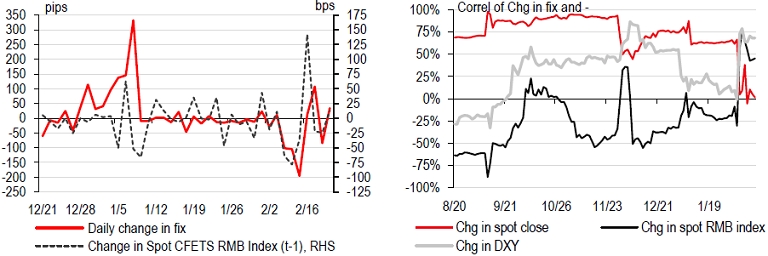Some subtle but notable changes are seen in PBoC's FX policy after China's return from the New Year holiday on 15 February. PBoC's daily USD-CNY fixings have been showing larger two-way volatility after a period of stability amid the January market turmoil. The daily fluctuations have not been in line with the changes in the onshore 4:30pm closing price and the correlation of the daily change in the fixing versus the overnight movement in the China Foreign Exchange Trading System (CFETS) RMB index has risen.
Markets were speculating that the exchange rate would be kept stable before the meeting of the Group of 20 central bankers and finance ministers, due on Feb. 26 and 27 to discuss issues including China's excess capacity, oil prices and global growth. The move reiterates the Central Bank's intention on making the RMB more flexible.
PBoC Governor Zhou Xiaochuan in an interview with China's Caixin magazine published on 13 February had said that yuan's volatility versus the greenback will increase and the exchange rate is basically stable against the basket. CFETS noted that a combination of midpoint fixing from the central bank and the trade-weighted yuan exchange rate index was critical to the yuan's future reference in 2016.
"This shift in FX policy is a natural consequence of some improving risk appetite and a broadly stable USD, but it may also be a reminder, ahead of the G20 meeting on 25-26 February, that China is intent on making the RMB more flexible, and the CNY reference basket will draw out this message", notes HSBC in a research report.
Governor Zhou Xiaochuan will hold a news conference ahead of the meeting on Feb. 26 to answer questions from the media which could dispel recent confusion over China's yuan policy. Zhou had highlighted in the Caxin interview that China will not introduce capital controls, as it would be totally against the country's economic/financial reform agenda. Administrative measures to prevent speculative outflows have been and will continue to be implemented, but China will not reverse its path to internationalise its currency and liberalise its capital account.
"The RMB is expected to weaken further this year amid multiple episodes of "ease-then-squeeze", to gradually correct the currency's overvaluation and to help promote greater currency flexibility", adds HSBC.
Yuan eased against the dollar on Wednesday after the central bank fixed a softer midpoint. The spot market CNY opened at 6.5303 per dollar and was changing hands at 6.5307 at midday, while the offshore yuan CNH was trading 0.09 percent weaker than the onshore spot at 6.5364 per dollar. The onshore yuan softened 0.2 percent against the euro by midday at 7.1998. It also eased 0.3 percent against the Japanese yen, hovering at 5.8400 to 100 yen.
Changes in China's FX policy reiterate the Central Bank's intention for a more flexible RMB

Wednesday, February 24, 2016 11:36 AM UTC
Editor's Picks
- Market Data
Most Popular



 Ukraine war: Putin’s plan to fire up Zaporizhzhia power plant risks massive nuclear disaster
Ukraine war: Putin’s plan to fire up Zaporizhzhia power plant risks massive nuclear disaster  Think the RBA will lift rates on Melbourne Cup day? Don't bet your house on it
Think the RBA will lift rates on Melbourne Cup day? Don't bet your house on it  Extraordinary Vietnam fraud case exposes the inherent vulnerabilities of banks
Extraordinary Vietnam fraud case exposes the inherent vulnerabilities of banks  History for sale: what does South Africa’s struggle heritage mean after 30 years of democracy?
History for sale: what does South Africa’s struggle heritage mean after 30 years of democracy?  AI-powered ‘deep medicine’ could transform healthcare in the NHS and reconnect staff with their patients
AI-powered ‘deep medicine’ could transform healthcare in the NHS and reconnect staff with their patients  The 50th anniversary of Portugal’s Carnation Revolution
The 50th anniversary of Portugal’s Carnation Revolution  Inflation: why prices look likely to stay high in the UK and Ireland, and what that means for mortgages
Inflation: why prices look likely to stay high in the UK and Ireland, and what that means for mortgages  Why central banks are too powerful and have created our inflation crisis
Why central banks are too powerful and have created our inflation crisis  If central banks don't start cutting them soon, it could actually increase inflation
If central banks don't start cutting them soon, it could actually increase inflation  What central banks are doing to safeguard financial stability and why they must proceed with caution
What central banks are doing to safeguard financial stability and why they must proceed with caution  Fallout: an expertly crafted TV adaptation that manages to incorporate some of the best elements of gameplay
Fallout: an expertly crafted TV adaptation that manages to incorporate some of the best elements of gameplay 































